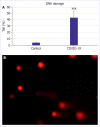Oxidative stress, DNA damage, and inflammation in COVID-19 patients
- PMID: 37435296
- PMCID: PMC10331251
- DOI: 10.14744/nci.2022.00947
Oxidative stress, DNA damage, and inflammation in COVID-19 patients
Abstract
Objective: Severe inflammation and oxidative stress seen in COVID-19 patients cause cumulative antiviral effects, and serious inflammation increases tissue, oxidative damage, and DNA damage. Therefore, in this study, oxidative stress, DNA damage, and inflammation biomarkers were investigated in patients diagnosed with COVID-19.
Methods: In this study, blood samples were obtained from 150 Covid-19 patients diagnosed by polymerase chain reaction and 150 healthy volunteers with the same demographic characteristics. Total oxidant status (TOS), total antioxidant status (TAS), total thiol (TT), native thiol, and myeloperoxidase (MPO) activities were measured by photometric methods. The levels of tumor necrosis factor-alpha (TNF-α), interleukin 1 beta (IL-1β), and interleukin 6 (IL-6), which are inflammation markers, were measured by the ELISA method using commercial kits. The genotoxic effect was evaluated by Comet Assay.
Results: The oxidative stress biomarkers; Disulfide, TOS, MPO, oxidative stress index, and IL-1β, IL-6, and TNF-α levels of inflammation biomarkers and the DNA damage in COVID-19 patients were increased (p<0.001), and the levels of TAS, TT, and NT In COVID-19 patients were decreased (p<0.001).
Conclusion: In COVID-19 patients, induced DNA damage, inflammation, and oxidative stress can guide the prognosis and treatment strategies of the disease.
Keywords: COVID-19; genotoxicity; oxidative stress.
© Copyright 2023 by Istanbul Provincial Directorate of Health.
Conflict of interest statement
No conflict of interest was declared by the authors.
Figures

Similar articles
-
Evaluation of Oxidative Stress and Inflammatory Biomarkers Pre and Post-Treatment in New Diagnosed Atherosclerotic Patients.Clin Exp Hypertens. 2022 May 19;44(4):320-325. doi: 10.1080/10641963.2022.2036993. Epub 2022 Feb 17. Clin Exp Hypertens. 2022. PMID: 35172655
-
The role of oxidative stress and inflammation biomarkers in pre- and postoperative monitoring of prostate cancer patients.Free Radic Res. 2024 Feb;58(2):98-106. doi: 10.1080/10715762.2024.2320381. Epub 2024 Feb 23. Free Radic Res. 2024. PMID: 38373238
-
Evaluation of oxidative stress and inflammation in patients with polycystic ovary syndrome.Obstet Gynecol Sci. 2024 Jul;67(4):414-420. doi: 10.5468/ogs.24031. Epub 2024 May 17. Obstet Gynecol Sci. 2024. PMID: 38757191 Free PMC article.
-
Investigation of DNA damage, oxidative stress, and inflammation in synthetic cannabinoid users.Hum Exp Toxicol. 2020 Nov;39(11):1454-1462. doi: 10.1177/0960327120930057. Epub 2020 Jun 8. Hum Exp Toxicol. 2020. PMID: 32508150
-
Comparison of oxidative stress parameters, thiol-disulfide homeostasis, and pro-inflammatory cytokines levels in patients with bipolar disorder and their first-degree relatives.J Psychiatr Res. 2023 Jun;162:103-112. doi: 10.1016/j.jpsychires.2023.05.022. Epub 2023 May 2. J Psychiatr Res. 2023. PMID: 37148601
Cited by
-
A Comparative Study on Genotoxic and Oxidative DNA Damage in Oral Epithelial Cells of COVID-19 Suspected Patients.Cureus. 2025 Apr 19;17(4):e82593. doi: 10.7759/cureus.82593. eCollection 2025 Apr. Cureus. 2025. PMID: 40390722 Free PMC article.
-
Dynamic Thiol-Disulfide Homeostasis Post-COVID-19 Depends on Age, Gender, and Symptom Severity.Cureus. 2024 Oct 22;16(10):e72097. doi: 10.7759/cureus.72097. eCollection 2024 Oct. Cureus. 2024. PMID: 39575049 Free PMC article.
-
Genotoxic consequences of viral infections.Npj Viruses. 2025 Jan 27;3(1):5. doi: 10.1038/s44298-024-00087-5. Npj Viruses. 2025. PMID: 40295867 Free PMC article. Review.
-
Effects of COVID-19 Disease on DNA Damage, Oxidative Stress and Immune Responses.Toxics. 2023 Apr 18;11(4):386. doi: 10.3390/toxics11040386. Toxics. 2023. PMID: 37112613 Free PMC article.
-
DNA Damage in Moderate and Severe COVID-19 Cases: Relation to Demographic, Clinical, and Laboratory Parameters.Int J Mol Sci. 2024 Sep 24;25(19):10293. doi: 10.3390/ijms251910293. Int J Mol Sci. 2024. PMID: 39408623 Free PMC article.
References
-
- Lov DK, Alkhovsky SV. Source of the COVID-19 pandemic: ecology and genetics of coronaviruses (Betacoronavirus: Coronaviridae) SARS-CoV, SARS-CoV-2 (subgenus Sarbecovirus), and MERS-CoV (subgenus Merbecovirus) Vopr Virusol. 2020;65:62–70. - PubMed
LinkOut - more resources
Full Text Sources
Research Materials
Miscellaneous
